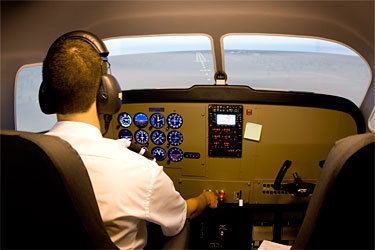Learn More About PUC
Aviation Students "Fly" the Frasca 180
By David Ranzolin on March 13, 2009
Share this

Although the newest member of the aviation program's fleet was purchased in the summer of 2008, it has yet to leave the ground. It lacks an engine and wings, but its usefulness is hailed by students and flight instructors alike. Meet the Frasca 180, Pacific Union College's new "flight training device."
The advancement of technology has had an untold impact on modern instruction. Perhaps nowhere is this more clear than in the realm of aviation and the development of flight simulators. The PUC aviation program understands that any technology promoting more efficient learning in non-life threatening conditions is worth its weight in gold. Housed safely in Fisher Hall, the Frasca 180 provides both, and affords peace of mind to students and - especially - to parents.
The flight simulator allows student pilots to test their abilities against every aerial hazard imaginable, all within the safety of Fisher Hall. "We can 'weather' the airplane any way we like," says flight center director Bill Price. "We can fail various pieces of equipment and force the pilot to fly in snow, hail, fog and turbulence." Frankly, if it happens in an airplane, it can happen in the flight simulator. The sense of realism is so highly regarded by the aerospace industry that pilots can actually complete or maintain their certification for certain pilot classes by using it, saving time as well as fuel expenditures. "While using the simulator, people have been known to fall over as they attempt to reconcile what they perceive as actual movement," observes senior aviation major Blake Segoria. "I am sometimes surprised at the end of a lesson that I haven't gone anywhere and that my 'airplane' is lacking wings, fuselage and tail!"
A "freeze button" that momentarily halts the simulation allows the instructor to coach students through aerial emergencies. This kind of preparation greatly reduces a student's anxiety throughout the training process and makes a monumental difference when actually airborne.
It is here that Price grudgingly admits that there may actually be some benefit to a youth's experience with another type of virtual simulator technology: video games. He concedes that the younger generation's familiarity with video games allows them to grasp certain flying techniques and concepts quicker. However, he wants to be clear that he is in no way encouraging students to spend their time playing video games. "The only redeeming quality to video games is that it helps them pick [flying] up quicker," he says.
Latest News
Maxwell Scholar Feature: Liah Ronneburg
By Marina Maher on December 30, 2025
First Set of PUC’s North Coast Nursing Students Graduate
By Ally Romanes on December 23, 2025
Two Tonge Grants Awarded to M.A. in Communication and Aviation Program
By Marina Maher on December 22, 2025
PUC’s College Days Creates Lasting Connections
By Ally Romanes on December 18, 2025
